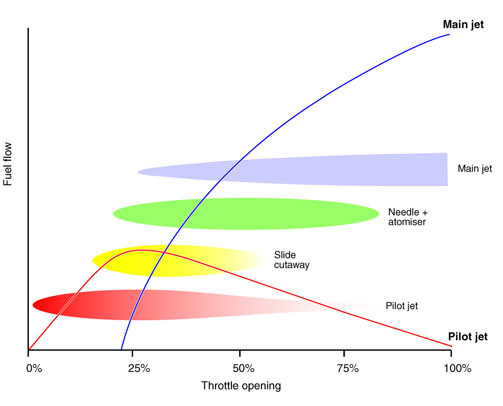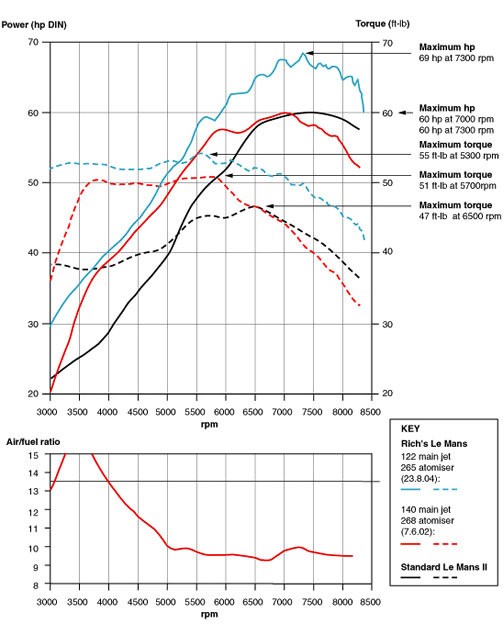Dyno runs
Owing to the extensive engine modifications, the carburettors needed to be tuned to ensure that the ratio of the air-fuel mixture is correct. The mixture should ideally be a constant 13.5:1 (air:fuel) – too rich or too weak will not only reduce the power but can seriously damage the engine. The role that the various carburettor circuits play in controlling the ratio of the air-fuel mixture is shown in Figure 1.

Figure 1. How a carburettor controls the mixture at different throttle openings.
After a bit of trial and error, the carburettor settings directly after the rebuild were stock except for 65 pilot jets, 268 atomisers and S&B oval-type air filters. I used the larger 65 pilot jets as I couldn’t get a reliable tickover with the smaller standard jets, and the larger-than-standard atomiser richened the mid-range, which I expected to be weak owing to the engine tuning.
The bike was taken to a dyno in early 2002, after the engine had been fully run in. Further dyno runs were made in August 2004. Figure 2 shows the dyno results, plus curves from a standard Le Mans II for comparison (from a road test published in a 1980s bike magazine, not from my bike).

Figure 2. Dyno results: rear-wheel DIN horsepower and torque (Fuchs BEI251 dyno). Key: black, standard Le Mans II; red, my Le Mans, 2002 run; blue, my Le Mans, 2004 run (exhaust gas not analysed).
| Larger, higher-quality version of this chart (PDF file, 30 kB) |
June 2002
On investigation of the dyno charts, the air:fuel ratio was far too rich, dropping to 10:1 by 5000 rpm, which sapped power and caused the sudden drop-off in horsepower. I was expecting the carburation to be weak owing to the tuned engine, and so did not have any smaller jets with me to try out.
Once home I made the following changes: 130 mains, needle on the 1st notch. When tested, the bike pulled a lot harder at high revs.
It seems my findings are similar to those of Ed Milich, who owns a tuned Le Mans IV (see his comments on carb tuning and dyno runs).
August 2004
It took a while to get around to running the bike on a dyno again to fine tune the carburation.
The 130 main jets were still too large, and at the end of the dyno session I ended up with 122 mains and the needle on its lowest position, to weaken the mixture at small throttle openings. Main jets larger than 128 caused the power to to tail off dramatically. Unfortunately, a gas analyser was unavailable, so the air:fuel ratio could not be examined.
Note the large increase in power at both low and high revs. At low revs, it’s truly stump pulling!
September 2004
After a bit more trial and error testing, I decided that the low- to mid-range was still somewhat rich even after the dyno runs, so I’m now using the standard 265 atomisers and 60 pilot jets instead of the larger ones I fitted immediately after the rebuild. (The engine has loosened up nicely, and, conveniently, ticks over with the smaller pilot jets.)
 Dyno runs
Dyno runs
